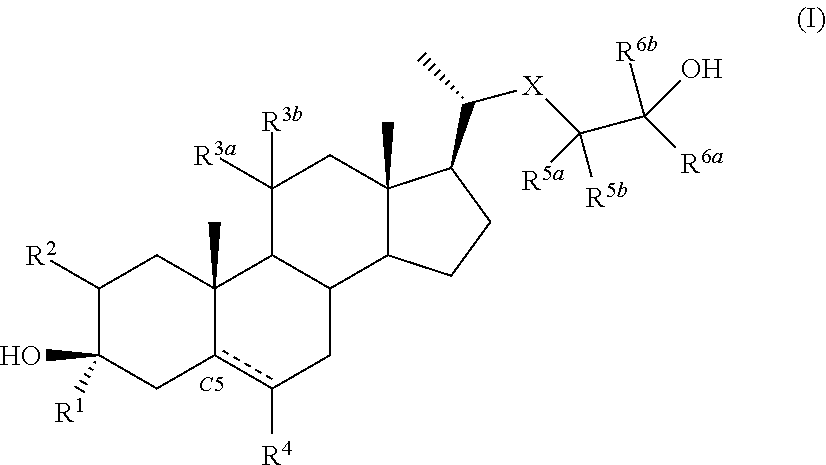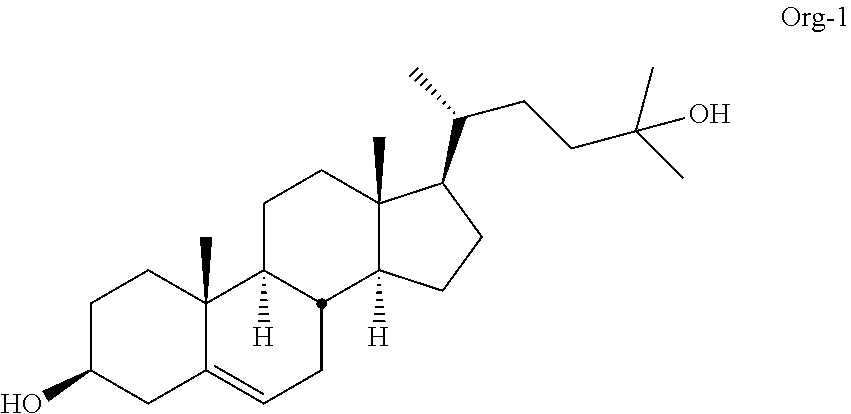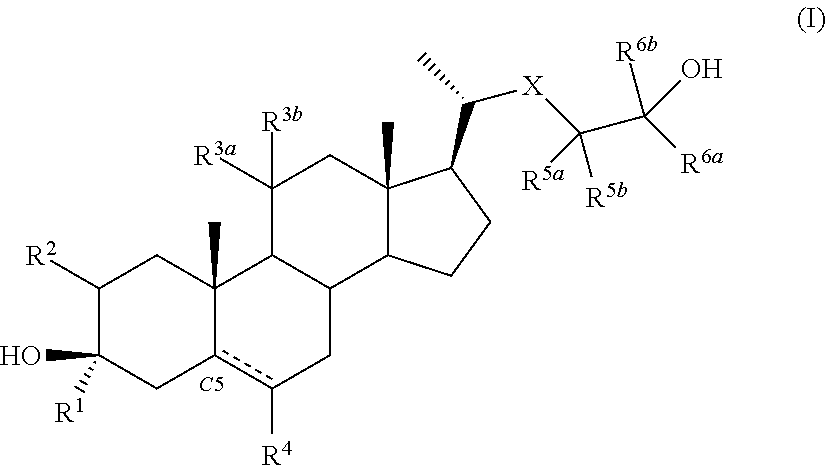Neuroactive steroids and methods of use thereof
a technology of neuroactive steroids and steroid receptors, applied in the field of neuroactive steroids, can solve the problems of significant loss of nmda potentiation, and achieve the effects of increasing the metabolic stability of these compounds, reducing the risk of adverse effects, and improving the effect of nmda potentiation
- Summary
- Abstract
- Description
- Claims
- Application Information
AI Technical Summary
Benefits of technology
Problems solved by technology
Method used
Image
Examples
example 1
[0209]
[0210]Preparation of Compound 1-2.
[0211]To a solution of ketone 1-1 (50.0 g, 0.17 mol) and ethylene glycol (62 mL) in toluene (600 mL) was added p-toluenesulfonic acid (1.4 g, 7.28 mmol). The reaction mixture was refluxed overnight with a Dean-Stark trap. The mixture was cooled to room temperature, diluted with ethyl acetate (500 mL), and washed with saturated aqueous sodium bicarbonate (300 mL×2) and brine (300 mL×2). The organic phase was dried over sodium sulfate and concentrated in vacuum to afford crude product 1-2 (64.0 g, 100%) which was directly used in the next step without further purification. 1H NMR: (400 MHz, CDCl3) δ 5.35 (d, J=5.6 Hz, 1H), 3.97-3.82 (m, 4H), 3.59-3.47 (m, 1H), 2.34-2.21 (m, 2H), 2.06-1.94 (m, 2H), 1.90-1.74 (m, 3H), 1.73-1.64 (m, 1H), 1.63-1.33 (m, 10H), 1.32-1.19 (m, 1H), 1.14-1.03 (m, 1H), 1.01 (s, 3H), 0.99-0.93 (m, 1H), 0.86 (s, 3H).
[0212]Preparation of Compound 1-3.
[0213]To a solution of compound 1-2 (32 g, 96 mmol) in dry CH2Cl2 (1200 mL) ...
example 2
[0238]
[0239]Preparation of 2-2.
[0240]To a solution of MAD (28.87 mmol, freshly prepared) in toluene (20 mL) was added dropwise a solution of 2-1 (4 g, 9.62 mmol) in toluene (20 mL) at −78° C. during a period of 1 h under nitrogen. Then the reaction mixture was stirred for 30 min, a solution of EtMgBr (29 mL, 28.87 mmol, 1.0 M in toluene) was added dropwise at −78° C. The reaction mixture was warmed to −40° C. and stirred at this temperature for 3 hours. TLC (petroleumether:ethyl acetate=3:1) showed that the starting material was consumed completely. The mixture was poured into aqueous saturated NH4Cl solution (200 mL) and extracted with EtOAc (150 mL×2). The combined organic phases were dried over Na2SO4, and the solvent was evaporated to afford crude product. The crude product was purified by column chromatography on silica gel (eluent: petroleumether:ethyl acetate=15:1) to give the product 2-2 (2.0 g, 47.6%) as white powder. 1H NMR: (400 MHz, CDCl3) δ 5.28 (d, J=5.2 Hz, 1H), 3.69 ...
example 3
[0267]
[0268]Preparation of 3-2.
[0269]To a suspension of 3-1 (400 mg, 1.035 mmol) and CsF (76 mg) in toluene / THF (20 mL, 8 / 1) was added TMSCF3 (1.53 mL, 10.35 mmol) and the mixture was stirred for 20° C. at room temperature under nitrogen. TLC (petroleumether:ethyl acetate=3 / 1) showed the starting material was consumed completely. A solution of TBAF (6.8 mL, 1 M in THF) was added and the mixture was stirred for 4 h at room temperature. The mixture was diluted with MTBE (200 mL), washed with aq. saturated NaHCO3 solution (30 mL×3) and concentrated in vacuum. The residue was purified by column chromatography on silica gel (eluent: petroleumether:ethyl acetate=20:1) to afford 3-2 (220 mg, 46%) as white solid. 1H NMR: (400 MHz, CDCl3) δ 5.31 (d, J=2.0 Hz, 1H), 2.44-2.41 (m, 1H), 2.04-1.96 (m, 3H), 1.81-1.67 (m, 5H), 1.65-1.39 (m, 11H), 1.34-1.32 (m, 3H), 1.31-1.25 (m, 1H), 1.21-1.10 (m, 3H), 1.12-0.98 (m, 4H), 0.96 (s, 3H), 0.98-0.90 (m, 4H), 0.68 (s, 3H.)
[0270]Preparation of 3-3 and 3-4...
PUM
| Property | Measurement | Unit |
|---|---|---|
| membrane voltage | aaaaa | aaaaa |
| total volume | aaaaa | aaaaa |
| concentration | aaaaa | aaaaa |
Abstract
Description
Claims
Application Information
 Login to View More
Login to View More - R&D
- Intellectual Property
- Life Sciences
- Materials
- Tech Scout
- Unparalleled Data Quality
- Higher Quality Content
- 60% Fewer Hallucinations
Browse by: Latest US Patents, China's latest patents, Technical Efficacy Thesaurus, Application Domain, Technology Topic, Popular Technical Reports.
© 2025 PatSnap. All rights reserved.Legal|Privacy policy|Modern Slavery Act Transparency Statement|Sitemap|About US| Contact US: help@patsnap.com



